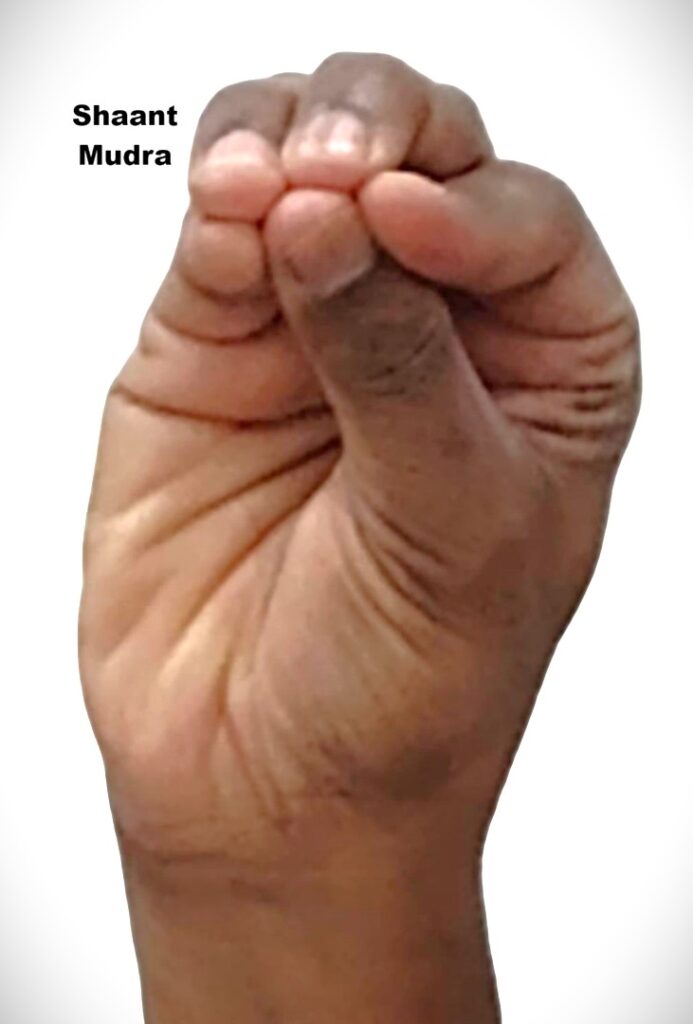Shaant Mudra
Introduction
Mudras are yogic hand gestures that regulate prana (vital energy) and influence physical, mental, and spiritual well-being. Shaant Mudra is a calming mudra, designed to promote mental peace, emotional stability, and relaxation.
The term “Shaant” in Sanskrit means “peace, calm, or tranquility.” This mudra is often practiced during meditation, pranayama, or times of stress to reduce anxiety, stabilize emotions, and harmonize the mind and body.
Meaning
Shaant = Calm, peaceful, tranquil.
Mudra = Yogic seal or gesture.
Purpose: To induce inner calm, reduce mental agitation, and harmonize prana, supporting both mental clarity and emotional balance.
How to Perform (Practice)
Sit comfortably in a meditation posture such as Sukhasana, Padmasana, or Vajrasana.
Relax shoulders, spine, and arms.
Form the mudra:
Place the tips of the index finger, middle finger, ring finger and little finger, together with the thumb, while the little finger remains extended.
Rest hands on your thighs or in front of the chest, palms facing upward.
Close your eyes and focus on breathing slowly, releasing tension, and cultivating inner peace.
Maintain the mudra for 5–15 minutes, gradually increasing duration with regular practice.
Tip: Keep hands relaxed; do not force fingers or thumbs.
Benefits
Physical Benefits
Reduces muscle tension, particularly in hands, arms, and shoulders.
Enhances circulation and pranic flow.
Supports relaxation of the nervous system.
Mental & Emotional Benefits
Reduces stress, anxiety, and mental agitation.
Promotes mental clarity, emotional stability, and mindfulness.
Enhances focus and meditative awareness.
Spiritual Benefits
Supports inner tranquility and calm mind, facilitating meditation and spiritual practices.
Harmonizes energy centers (chakras), especially the heart and mind connection.
Encourages balanced prana flow and subtle energy awareness.
Contraindications
Finger, hand, or wrist injuries.
Shoulder or forearm discomfort should be monitored during practice.
Avoid over-practice if hands or arms feel fatigued.
Anatomy & Physiology
Musculoskeletal: Engages intrinsic hand muscles, stabilizes fingers, and lightly activates forearm muscles.
Circulatory system: Improves blood flow in fingers, hands, and upper limbs.
Nervous system: Stimulates sensory nerves, promoting parasympathetic activation and relaxation.
Endocrine system: Supports subtle energy centers associated with stress regulation, calmness, and emotional stability.
Kinesiology
Fingers form a stable, relaxing seal, directing energy inward.
Hands relaxed on thighs or chest, with neutral wrist alignment.
Shoulders relaxed, elbows slightly bent.
Enhances hand stability, proprioception, and subtle energy awareness.
Neurology
Activates peripheral nerve endings, enhancing mind-body integration.
Promotes parasympathetic nervous activity, reducing stress and promoting calm.
Supports cortical regions associated with attention, emotional regulation, and relaxation.
Enhances subtle energy perception and internal balance during meditation.
Duration of Mudra
Beginners: 5 minutes.
Intermediate: 10–15 minutes.
Advanced: 20–30 minutes during meditation or pranayama.
Tip: Daily practice promotes mental peace, emotional stability, and inner harmony.
Counter Mudra
Gyan Mudra: To combine relaxation with mental clarity.
Prana Mudra: To energize after calming practice.
Apana Mudra: To release stagnant energy before practicing Shaant Mudra.
Conclusion
Shaant Mudra is a calming mudra that reduces stress, promotes inner peace, and harmonizes mind, body, and energy. Regular practice provides physical relaxation, mental clarity, and emotional stability, making it ideal for meditation, pranayama, and daily stress management.
FAQ
Q1. Can beginners practice this mudra?
Yes, it is safe and suitable for all levels.
Q2. Can it help with anxiety or stress?
Yes, it promotes calmness, mental clarity, and emotional balance.
Q3. How long should it be practiced daily?
5–15 minutes for beginners; up to 30 minutes for advanced practitioners.
Q4. Can it be combined with meditation or pranayama?
Yes, it enhances meditation, breathing practices, and mindfulness.
References
Swami Satyananda Saraswati, Asana, Pranayama, Mudra, Bandha.
B.K.S. Iyengar, Light on Yoga.
Hatha Yoga Pradipika – Mudras for mental calmness and energy balance.
Gheranda Samhita – Mudras for emotional stability and meditation.
Kuvalayananda, Yoga Mimamsa Journal.

